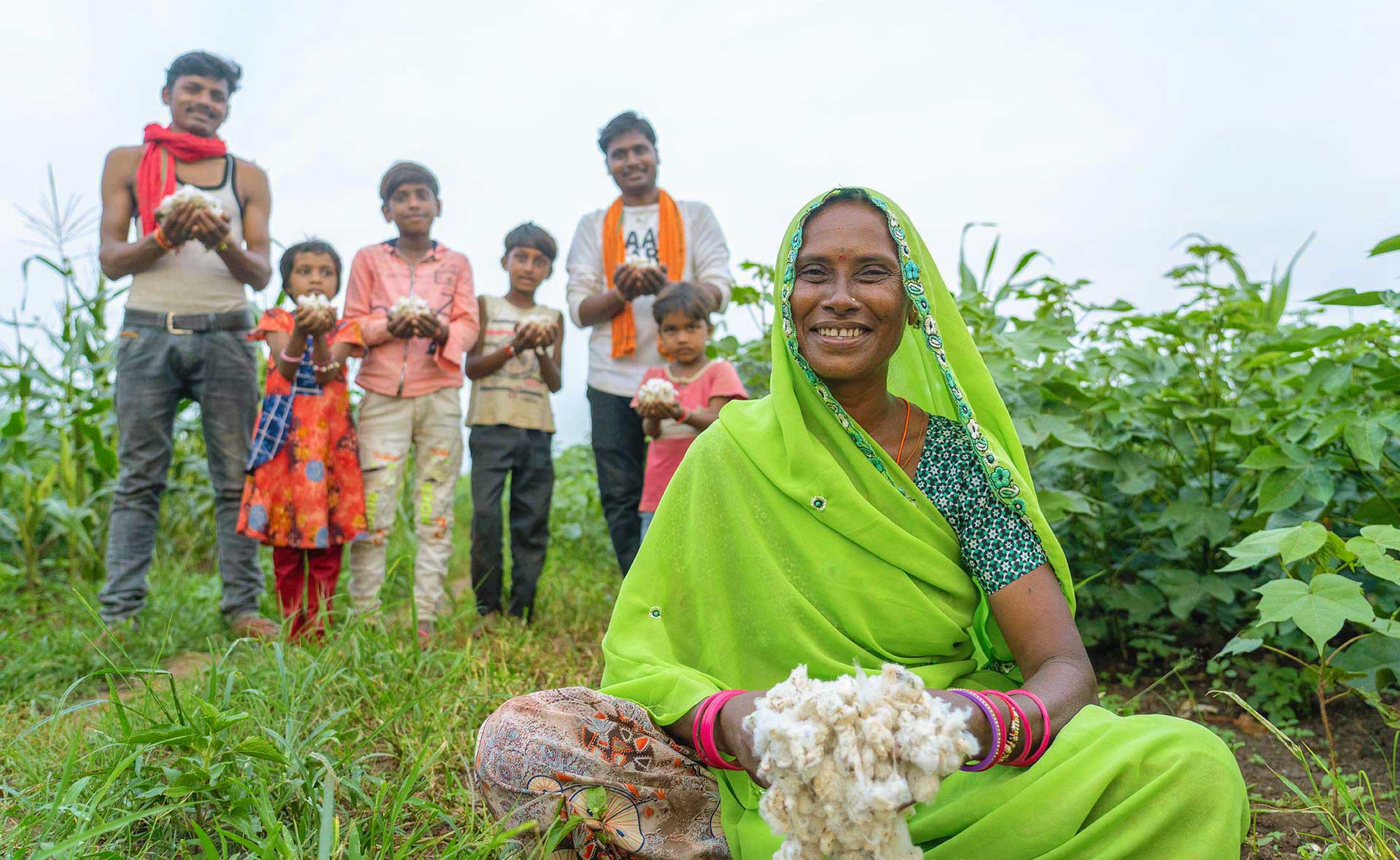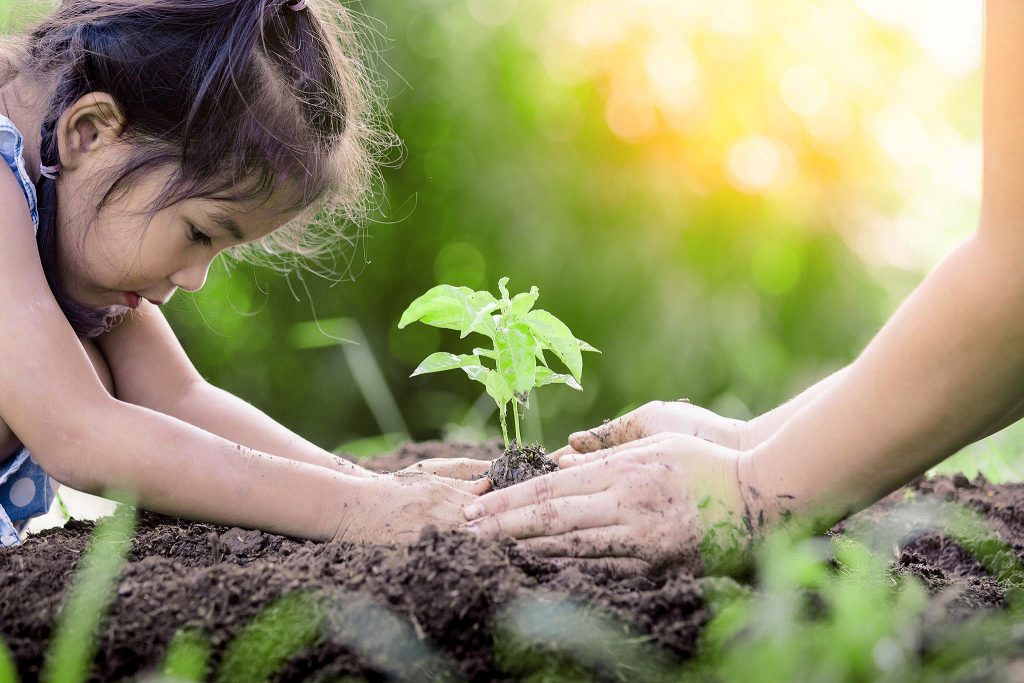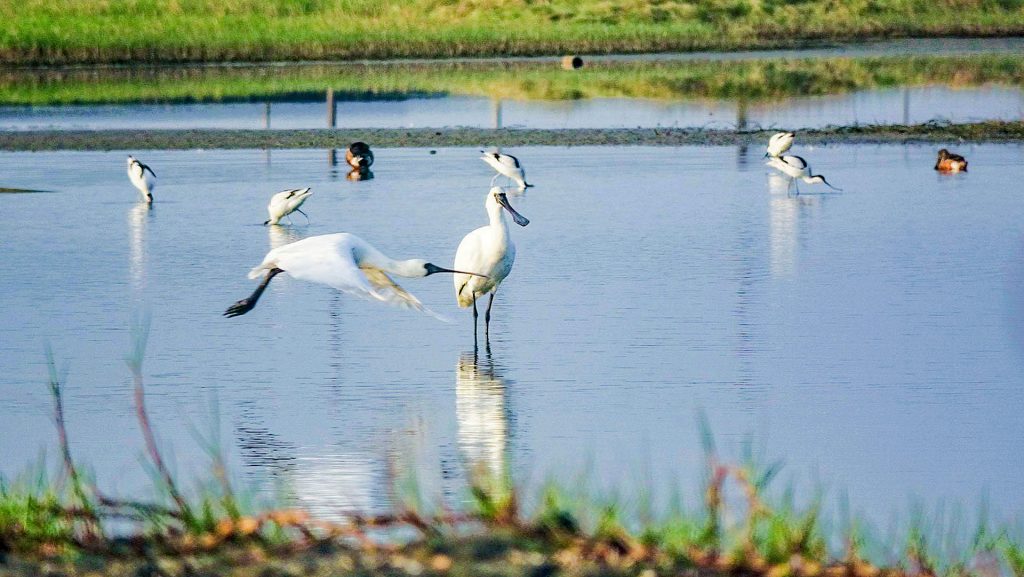
Transforming Lives with
Organic Cotton
How a transition finance program is helping Indian farmers make the switch to organic cotton farming to improve lives and livelihoods.
As September turns to October, farms in the heartland of Madhya Pradesh witness pink blossoms ripening into seed pods that burst open to reveal fluffy white cotton.
But, behind these blooming cotton fields is a grim reality. Cotton production is already water-intensive and in some instances, toxic agrochemicals and genetically modified seeds put significant stress on the environment and the lives of cotton farmers.
But local farmers are discovering that there’s a better way — for the environment and their livelihoods.

A wave of change
Cotton is big business, and India is the largest producer of cotton in the world, contributing 26 percent to the total global production. Supporting this thirsty cash crop depletes India’s already scarce ‘blue’ water resources such as groundwater reservoirs.
Furthermore, traditional cotton farming predominantly uses genetically modified seeds, after farmers discovered they were resistant to pests. However, over the years, pests have developed resistance to the pesticides used in traditional cultivation methods, leading to farmers deploying unregulated chemical pesticides and fertilizers to save their crops.

For 25 years, Action for Social Advancement (ASA) has been promoting farm-based livelihoods of small and marginal farmers. In 2015, the non-profit organization started building the Organic Cotton Cultivation Program. They were faced with a big challenge — convincing farmers there was a better way to grow cotton and provide for their families.

Organic cotton farming relies on non-chemical inputs such as bio-manures, crop rotation, and inter-cropping for sustainable, ecological, and biodynamic agriculture. And this translates into long-term benefits for people and the planet.
The switch to eco-farming
In Asalya, a small hamlet in Madhya Pradesh, Central India, a quiet eco-revolution is underway — out of 392 households, 133 cotton farmers have gone organic. And guiding them on this shift is the ASA.
Initially skeptical, farmer Sushila Varkaya was among the first in her village to commit to this new opportunity. “We were barely making ends meet even after toiling away on the field daily. So, when ASA approached me, I decided to give organic farming a try,” says Varkaya, whose family has been working the farm for many generations. Initially, she dedicated a small plot of her land to test organic cotton farming. With training provided by ASA field officers on agronomy and good agricultural practices, within a few years, she was reaping the rewards of organic farming.

Previously, there was little to no in-person education available to farmers on pesticides and no real access to personal protection kits. “We would do what everyone was doing. If our neighbors sprayed twice, we’d spray twice. If someone sprayed thrice, we’d follow suit,” explains Varkaya. Subsequently, high volumes of chemicals in the air, water supply, and even soil led to farming communities and their livestock facing recurring health issues.
Once Varkaya switched completely to organic, she stopped buying expensive fertilizers and pesticides altogether. Natural products enhanced soil fertility and plant health, increasing biodiversity.
The soil on an organic farm is airy and supple, and not hard as seen on traditional lands, perhaps because of more carbon sequestration.
Ashis Mondal, Director, ASA
According to Textile Exchange, on average, organic cotton cultivation almost halves the CO2 emissions compared to traditional cultivation per 1000kg of cotton; 978kg CO2 versus 1,808kg CO2.
Organic cotton currently only accounts for 2 percent of India’s total cotton cultivation, meaning there’s plenty of room for improvement. To change this, the ASA and other organizations are working hard to increase community outreach and awareness of this movement.
Safeguarding the future
Some of the farmers of Asalya are members of the Petlawad Farmer Producer Organization (FPO) and Varkaya is one of its directors. The FPO has played a significant role in improving independent farmers’ access to resources, facilitating policy-making decisions, and increased market access.
Despite these advancements, smallholder farmers are stuck in a perennial debt trap. While the desire to change might be there, many face seemingly impossible financial barriers. “Traditionally, farming has been a credit-led business. Local pawnbrokers, money lenders, and traders fund the farmer on exorbitant interest rates of up to 60 percent,” says Mondal. “So, the need for fair credit was evident from day one.”

Support came in the form of DBS Bank’s pilot organic cotton procurement financing. DBS customized this unique program for its partnership with global clothing company Inditex (owner of brands including Zara, Massimo Dutti, and Bershka) to leverage the network of local FPOs to reach more than 2,000 farmers. Inditex had set a target to use only sustainable materials such as organic or recycled cotton, linen, and recycled polyester by 2025. The DBS program makes the connect between these FPOs and farmers with an international buyer more feasible, and thus, guarantees them a steady revenue stream.”

Farmers require immediate payment post-harvest. The arrangement of adequate, reliable, and competitively priced funds ensured that the farmers’ produce would not be lost to the traditional market just because they needed quick cash. With the DBS program, distress selling is reduced because the price is fixed beforehand.
Mr. Arvind Sharma, Executive Director and Head of Priority Sector Lending, DBS Bank India Limited
This program has now been scaled to reach over 25,000 farmers. It not only aims to improve the lives and livelihoods of marginal farmers, but it is also a singular model with a goal of decarbonization. It can provide a much-needed pathway for companies in the fashion and apparel industry to adapt their supply chains to be more inclusive and carbon-conscious in a resource-scarce world, while concurrently providing consumers with easier access to more sustainably produced products. These examples of transition financing models will be key for financial institutions to enable companies to meet SDGs and achieve net zero emissions.
New Horizons
Looking ahead to the future, Mondal is confident this wave of change will not stop at economic benefits and environmental impact. He views organic farming as a vital component in India’s road map to strengthen the rural economy. “Organic farming is labor-intensive. So, people in rural communities don’t need to migrate to Indore or Kota in search of jobs. They get a sustainable livelihood back home.”

Sushila Varkaya has been able to turn her life around. “Our farming was like a gamble,” says Varkaya. “Our financial standing used to run in only loss. After adopting organic farming, our overall income from farming has increased by 20-25 percent through a reduction in the cost of cultivation and by price premium.” Today, she can dream and work towards fulfilling it.
I plan to make my small grocery shop — I started it two years ago — bigger. But the immediate plan is to make my village a fully organic village.
Sushila Varkaya, farmer
Read more







